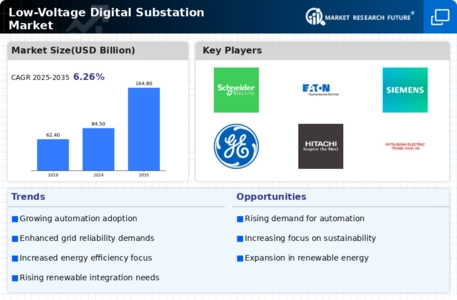Integration of IoT Solutions
The integration of Internet of Things (IoT) solutions into the Low-Voltage Digital Substation Market is driving significant advancements. IoT technologies facilitate real-time monitoring and control of substations, enhancing operational efficiency. This integration allows for predictive maintenance, reducing downtime and operational costs. According to recent data, the adoption of IoT in substations is expected to increase by over 30% in the next five years. This trend indicates a shift towards more automated and intelligent systems, which are essential for modern energy management. As utilities seek to optimize their operations, the demand for IoT-enabled low-voltage digital substations is likely to grow, reflecting a broader trend towards smart grid technologies.
Increased Focus on Cybersecurity
The increased focus on cybersecurity within the Low-Voltage Digital Substation Market is becoming a critical driver. As substations become more interconnected and reliant on digital technologies, the risk of cyber threats escalates. Utilities are prioritizing cybersecurity measures to protect their infrastructure from potential attacks. This heightened awareness is leading to investments in advanced security solutions, which are projected to grow by 25% in the coming years. The emphasis on cybersecurity not only safeguards operational integrity but also builds consumer trust in digital substations, thereby fostering a more resilient energy landscape.
Rising Demand for Renewable Energy
The rising demand for renewable energy sources is a pivotal driver in the Low-Voltage Digital Substation Market. As countries strive to meet sustainability goals, the integration of renewable energy into existing grids necessitates advanced substation technologies. Low-voltage digital substations play a crucial role in managing the variability of renewable energy sources such as solar and wind. Market data suggests that the share of renewables in the energy mix is projected to reach 50% by 2030, necessitating upgrades in substation infrastructure. This transition not only supports energy diversification but also enhances grid reliability, making low-voltage digital substations indispensable in modern energy systems.
Government Initiatives and Regulations
Government initiatives and regulations aimed at modernizing energy infrastructure are significantly influencing the Low-Voltage Digital Substation Market. Many governments are implementing policies that promote the adoption of digital technologies in substations to enhance grid resilience and efficiency. For instance, regulatory frameworks are increasingly favoring investments in smart grid technologies, which include low-voltage digital substations. This regulatory push is expected to result in a market growth rate of approximately 15% annually over the next decade. Such initiatives not only facilitate technological advancements but also ensure compliance with environmental standards, thereby driving the demand for innovative substation solutions.
Technological Advancements in Automation
Technological advancements in automation are reshaping the Low-Voltage Digital Substation Market. Automation technologies, including advanced control systems and artificial intelligence, are being integrated into substations to enhance operational efficiency and reliability. These innovations allow for remote monitoring and automated fault detection, which can significantly reduce response times during outages. Market analysis indicates that the automation segment within the substation market is expected to grow by 20% over the next five years. This growth reflects a broader trend towards digitization in the energy sector, where automated solutions are becoming essential for managing complex energy networks.

















Leave a Comment